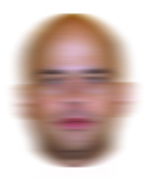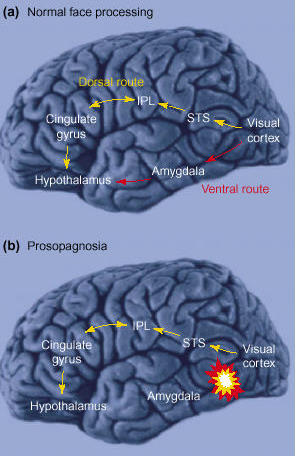Prosopagnosia
From Psy3242
Prosopagnosia
Contents |
Definition
Prosapagnosia is defined as the inability to perceive faces, or face blindness. It is a type of agnosia, a term used in neuropsychology to mean lack of knowledge about a particular subject. The disorder has nothing to do with actual visual blindness, as the person is usually able to view everything else normally. It is a perceptual problem that prohibits people from being able to put the image of the face together as a whole. This rare disorder varies in intensity. One person with the disorder may not be able to recognize whether two pictures are of the same face or not, while another patient may affect recognition of one's own family members. In a most severe example, a person may no longer be able to recognize himself in a photograph or the mirror. These skills do not improve with practice or familiarity. Usually it is not limited to the recognition of individuals, but also of more basic facts such as gender and facial expression. The picture below gives the impression of what a person with prosopagnosia might see when looking at another person's face.
Prosopagnosia and the Brain
Through the use of many studies on the brain, including PET scans, it seems that prosopagnosia relates to damage to a particular part of the brain. There is an area on the right side of the brain that specializes in perception of people. These area, the ventral regions of the occipital and temporal lobes, have been found to be involved in perception of faces. It is suggested that posterior regions help to put together the individual characteristics of the faces, while the area in front of it aids in identification and memory of bibliographic information of the person to whom the face belongs.
In some cases, however, it is associated with bilateral damage, or damage on both sides of the brain. If the visual cortex is damaged on both side, prosopagnosia is not likely to be the only disorder. More generalized agnosias may occur, including the inability to recognize objects. This inclusion of the right brain extends from a lack of knowledge about faces, to a generalized lack of knowledge about objects in general.
Below the route of facial perception is described through the path of various parts of the brain. The dorsal route is intact, but in people with prosopagnosia, the ventral route is disturbed.
Further Information
The following link is to a site built by a woman with prosopagnosia. She describes in basic terms what she deals with on a daily basis, and some of the social consequences of the disorder.
This link brings you to the site for the National Institute of Neurological Disorders and Stroke, which provides some explanations about dealing with the disorder.
http://www.ninds.nih.gov/disorders/prosopagnosia/Prosopagnosia.htm
The following link is to a YouTube video providing a summary of the disorder.
http://www.youtube.com/watch?v=ZogbIvdgfzQ
References
The "further information" as well as the following resources were used for generating the information on this page.
Ogden, Jenni A. (1996). Fractured Minds. Oxford: New York.
Stirling, John. (2002). Introducing Neuropsychology. Psychology Press: New York.


